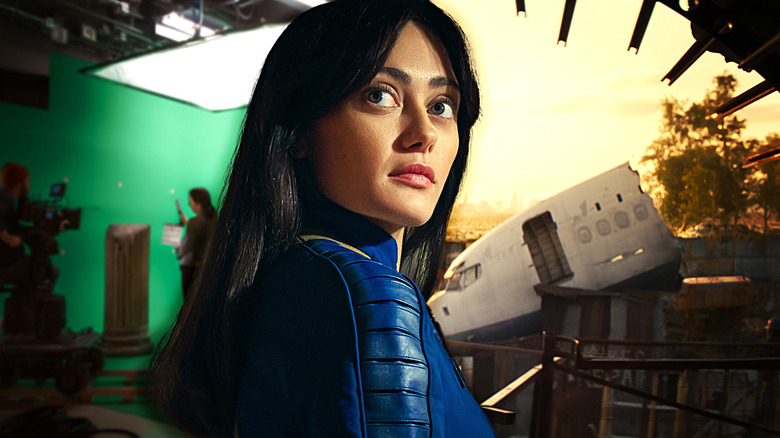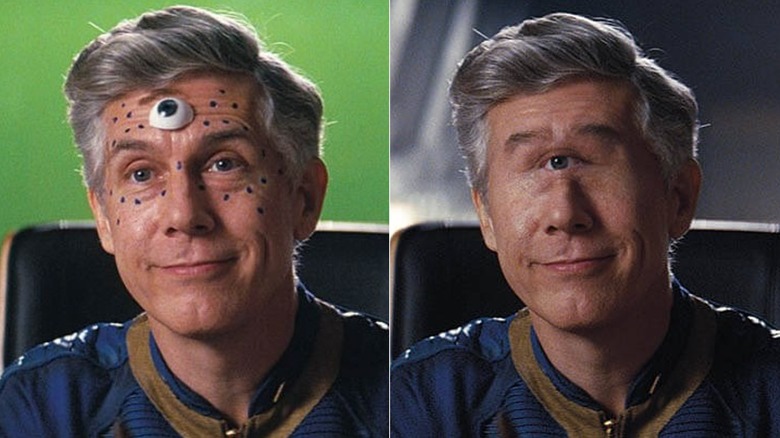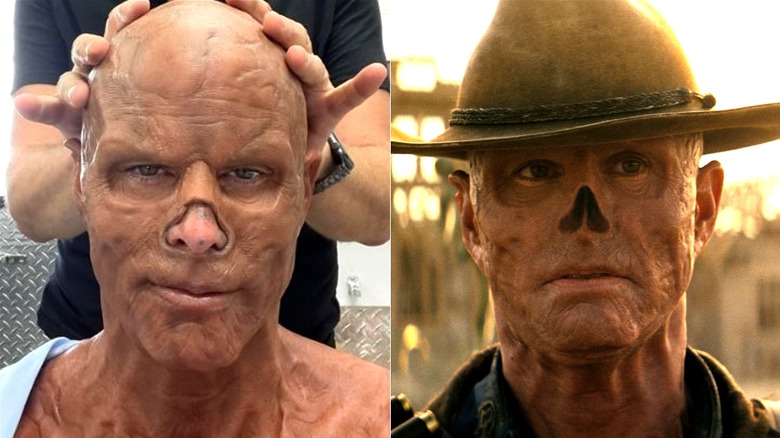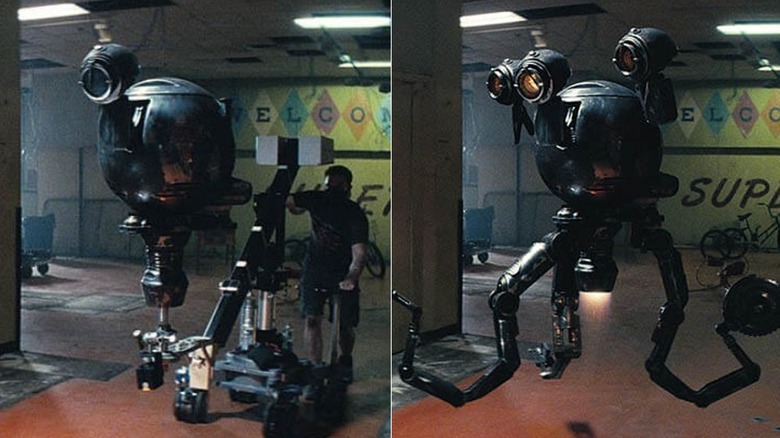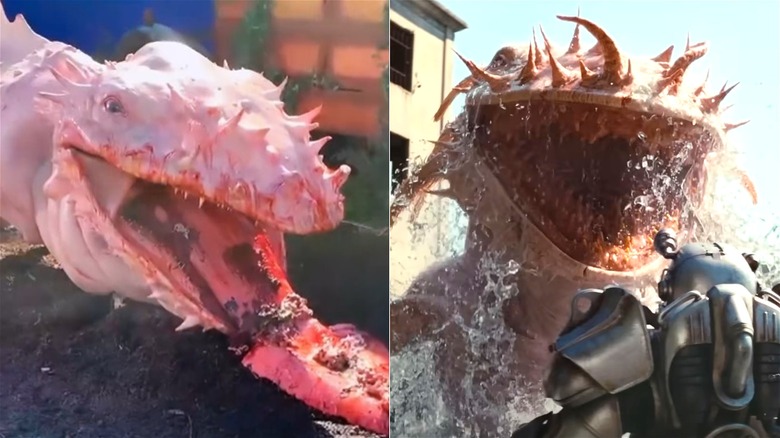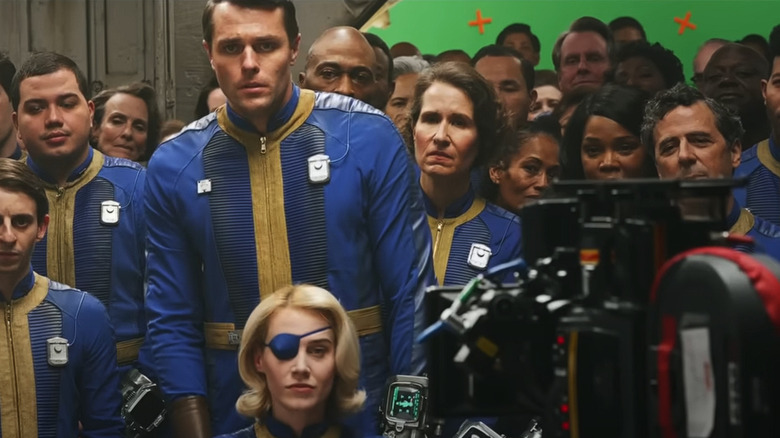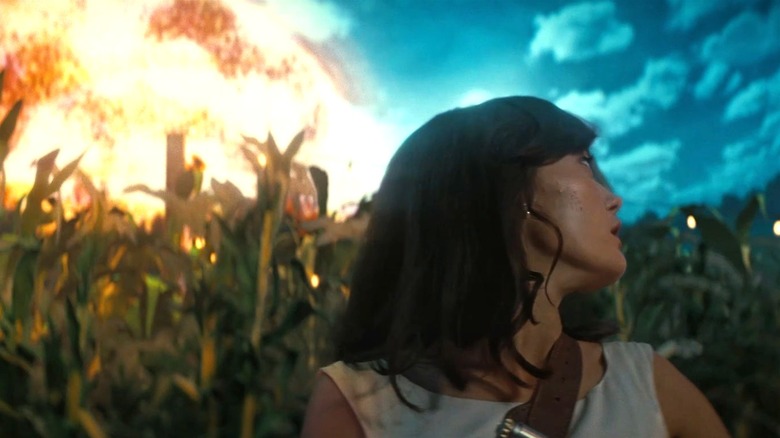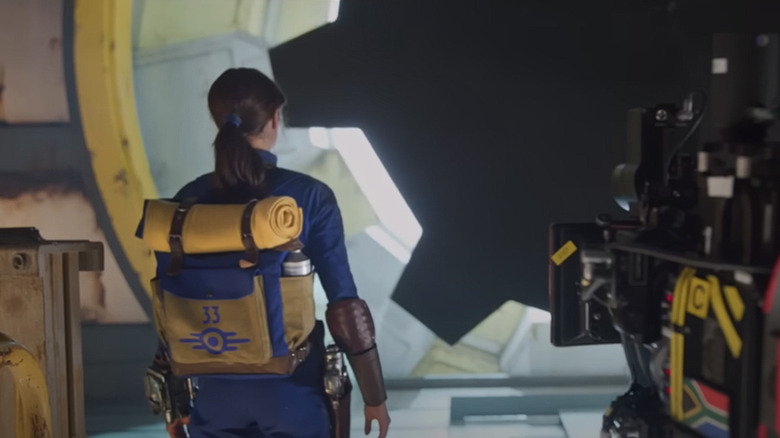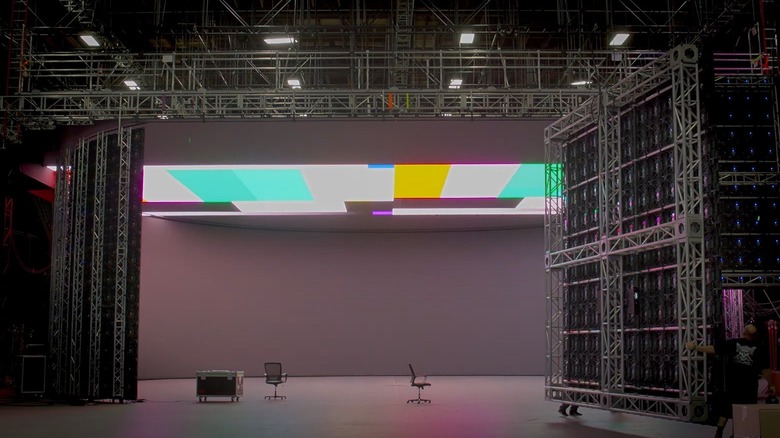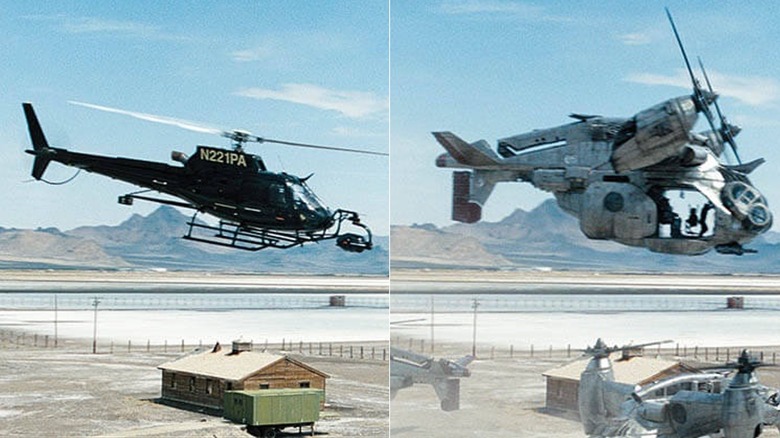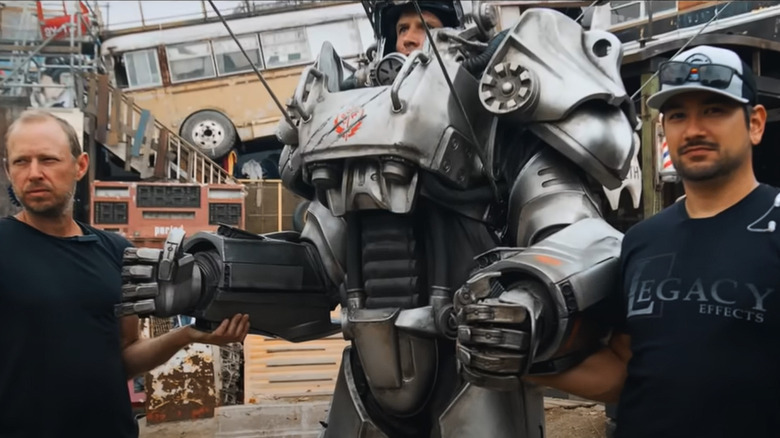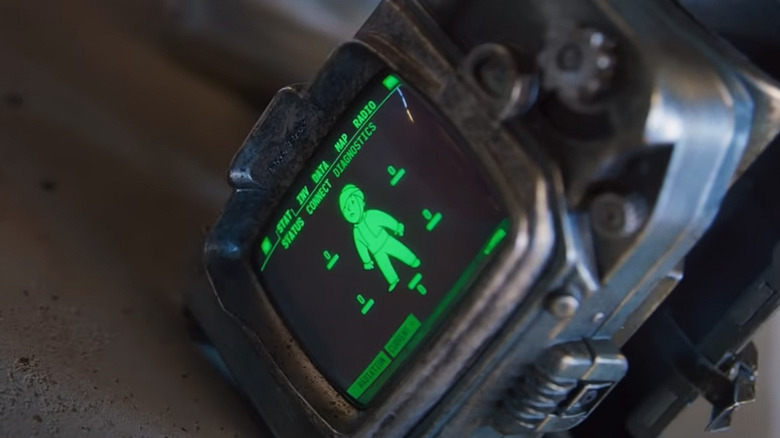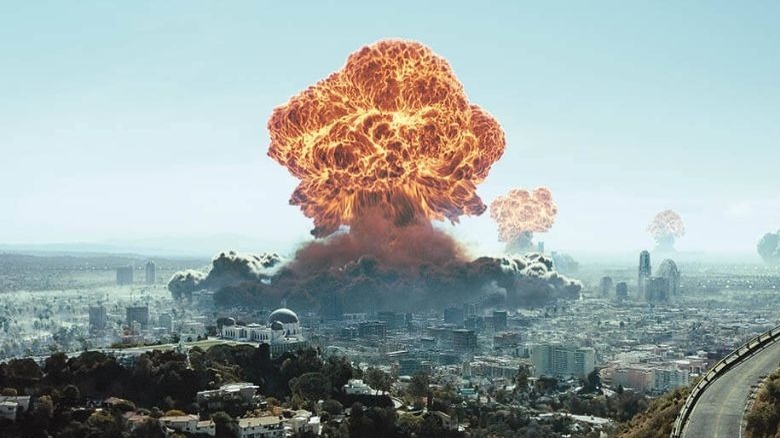What Fallout Looks Like Without Special Effects
The highly anticipated "Fallout" series finally dropped on Amazon Prime Video in April 2024, blowing away fans old and new while earning a fresh "Rotten Tomatoes" score – a rarity among video game adaptations. Though much of its success can be chalked up to the franchise's unique feel, some hilariously brutal moments of violence, and Walton Goggins' incredible performance as Cooper Howard/The Ghoul, the impact of the series' impressive special effects can't be discounted.
Led by VFX supervisor Jay Worth (a longtime collaborator of "Fallout" producers Lisa Joy and Jonathan Nolan), the show's special effects team brought even the game's most outrageous and surreal components to life. This involved puppets, complicated props, and make-up, in addition to over 3,300 VFX shots over the course of the first season. This overview of the whole process will give you a newfound appreciation for how the series accomplished some complex feats of filmmaking magic.
Chris Parnell's Cyclops was surprisingly difficult to nail
From Fred Armisen to Erik Estrada, the "Fallout" series filled out its supporting cast with a number of welcome and instantly recognizable faces. When it came time to cast Overseer Benjamin, the plucky (if openly xenophobic) leader of Vault 4 who plays quite a significant role in the series, actor and comedian Chris Parnell was the perfect choice. He was so good and became so central, in fact, that the VFX team began to worry that his work would be entirely erased after they molded his face into that of a mutated cyclops.
"The Cyclops, played by Chris Parnell, was one of the biggest challenges of the season because he's a character we see over multiple episodes," Jay Worth told VFX Voice. "We wanted to retain his amazing performance while figuring out how to replace the majority of his face." In the end, they deviated from the traditional cyclops look one might be familiar with from Greek mythology, instead trying to find something more "organic." Important Looking Pirates made his eye much smaller and also gave him two eyebrows, which apparently made the effect look more credible. "It sounds like a subtle thing, but that for me makes it feel like it's a real person with a real single eye," Worth said.
Walton Goggins had his nose removed in 500 shots
Chris Parnell wasn't the only performer who had their work filtered through VFX. Walton Goggins was transformed into "The Ghoul," a memorable character with full facial disfigurement. While the base layer of his striking look is accomplished through creature makeup, there was simply no practical way to achieve the nose (or lack thereof), the thing that really makes his appearance mesmerizing. Creating the Ghoul's face was "rough," Jay Worth told VFX Voice, with Indian VFX studio FutureWorks stepping in to remove Goggins' nose in at least 500 shots.
The many hours put into removing Goggins' nose by the VFX artists at FutureWorks is admirable, but so is the work of special effects makeup artist Jake Garber, who spent hours getting the actor into his Ghoul getup every day. "He's one of the best FX makeup artists in the world and a long time friend," Goggins said in an Instagram post. "When we started this process it took 5 hours. Jake got it down to 1:45-2:15 depending on what movie we were watching." The pair apparently watched Western films together as Goggins sat in the makeup chair, which helped put the actor at ease. "Everyday he dealt with my anxiety. Everyday he was my friend."
VFX artists turned a real hunk of metal into Snip Snip
English character actor Matt Berry gives us one of the most skin-crawling moments in "Fallout" Season 1. When the Ghoul finds himself suddenly in need of medicine, he resorts to selling a captive Lucy to organ traffickers operating out of an abandoned Super Duper Mart. Inside, Lucy is taken care of by a congenial robot voiced by Berry that has been affectionately named "Snip Snip" because it's now used for harvesting organs. Snip Snip is a fourth-generation Mister Handy, a brand of robotic helper manufactured and sold before the Great War. Unfortunately, it doesn't seem as though Berry himself was on the set to act with Purnell (admittedly, it would be tricky fitting anyone inside a Mister Handy), but that doesn't mean her scene partner was merely her imagination.
The creators of the show decided that it would be smart to build a skeleton for Snip Snip, which consisted of only the round body and center eye (almost definitely included so Purnell could have a clear, consistent spot to look at for shot-to-shot continuity and ease of editing). Later, during post-production, the Swedish VFX house Important Looking Pirates added two more eyes, three dangling arms, and other details that gave Snip Snip a more life-like feel (such as the glow in his center eye). They also removed the dolly that the skeleton was mounted on to create the illusion that Snip Snip was hovering above the ground.
The Gulper puppet really swallowed actors on set
The "Fallout" universe has no shortage of terrible creatures to terrorize its inhabitants with. From Radroaches to Deathclaws, which we'll finally see in live-action during Season 2, the Wasteland's wildlife is a large part of what makes this world so engrossing. Season 1 saw many characters come to blows with a Gulper, a deadly aquatic creature that (briefly) swallows the series' MacGuffin. VFX house Framestore was responsible for creating a CGI model of the monster, which is seen in the majority of the Gulper's shots throughout the first season. For certain sequences, however, there was an actual functioning Gulper puppet on set.
Quantum Creation FX made a Gulper puppet that had the ability to swallow and regurgitate actors, which was the fate of Squire Thaddeus (Johnny Pemberton). Jay Worth told VFX Voice: "We had this real object for our actors to interact with, for water to interact with, and it was even rigged so someone could get swallowed, which was vital to pull off the climactic moment between Max and Thad in Episode 3." In addition to enhancing the performance environment for the actors on set, having the puppet also allowed the camera to capture accurate light and shadow movement for the otherworldly-looking monster.
The Vaults were made by mixing practical sets with strategically placed green screens
Of all the faithful recreations made by Amazon's "Fallout," none are quite as immersive as the Vaults. These high-tech, quasi-torturous fallout shelters have been a staple of the franchise since the very first game, designed by the nefarious megacorp Vault-Tec to protect the privileged survivors of nuclear war. The "Fallout" TV series spends a large amount of time in the home-Vault of protagonist Lucy MacLean (Ella Purnell): Vault 33. As such, physical Vault environments were created, but they're not exactly how they appear on screen.
The challenge was not physically recreating an environment from the game, but communicating the key aspect that unifies all Vaults — their enormous size. To accomplish this, the VFX team would strategically place green screens on the physical sets behind open doorways and portals or where hallways were meant to be. This created the illusion that actors were standing in a seemingly endless underground bunker even when filming on sets not much larger than a studio apartment.
The burning cornfield had to simulate a damaged film reel
A key component of the "Fallout" mythos is the influence of the Atomic Age. In this universe, the discovery of nuclear power led not only to the production of weapons, but the widespread adoption of nuclear energy as a safe and reliable power source. This is largely why most of the tech seen in "Fallout" video games and in the Amazon series has a retro-futuristic look to it, with the vibe of the 1950s somehow bleeding deep into the 2070s.
One example of this tech can be seen in Vault 33. The centerpiece of the Vault is a vast field of corn, synthetically extended with the help of an advanced film projector. Just a few decades ago, this effect likely would have been accomplished with a green or blue screen, but with Magnopus' LED volume, this idyllic landscape could be created and displayed in real time, providing more realistic lighting for production and a more immersive environment for the actors to perform in.
It looks great, but using an LED volume for the cornfield created an issue in one Vault scene — the Raiders' destruction of the "field" in Episode 1, "The End." One of the most impactful visuals is the film projector catching fire, destroying the Vault's idyllic façade in a bright, billowing blaze. This meant the VFX artists had to render a projector fire that would be shown on a screen which had been created to surpass such outdated equipment.
Lucy's first steps outside the Vault were mostly real
With such an impressive blend of VFX techniques converging to bring the Vaults to life, it's almost more exciting to see what technical feats were accomplished practically. One such feat comes at the end of the first episode, when Lucy takes her first step out into the Wasteland. The Vaults of the "Fallout" world can only be opened by a large, complicated unlocking mechanism which sees a massive gear slowly roll out of the way to reveal the outside world. Getting this shot right was crucial, as it's how "Fallout" players start their own journeys in games like "Fallout 4."
The VFX team wasn't able to recreate this moment entirely with practical effects, but it got pretty close. As Lucy stands in front of the Vault 33 door, that's a real gear rolling to the side — at least, something shaped like a real gear. It's much more plain than the one seen in the show, made from a bland material that likely weighs significantly less than a real metal gear.
While this surely heightened the moment for Ella Purnell as a performer, the use of a practical "gear" probably had more to do with getting the lighting right. After all, recreating the shadows of a giant moving gear is likely more of a headache than just making one and casting real shadows. Once the scene was shot, VFX artists came in and added the iconic Vault-Tec designs, as well as finer details to make the gear look metal.
A massive LED wall helped bring the Wasteland to life
The Vaults aren't the only iconic locale that needed to be recreated for the "Fallout" series. Once players make it out of the Vaults, they are thrust into the Wasteland, the chaotic ruins of the United States. While vast desert areas might seem like easy places for location scouts to find, they're often impractical to film in, especially for productions as technically complex as "Fallout." So how did they do it? Like the groundbreaking Disney+ series "The Mandalorian," "Fallout" used an LED volume with realistic environments rendered in real time by Epic Games' Unreal Engine (yes, the very same engine that runs games like "Fortnite"). These environments could then move and react in order to mimic camera movement.
It may sound a bit complicated, but practices such as pre-visualization (which has been used by CGI-heavy projects since before the volume method was adopted) mean precise shots can be choreographed well ahead of time. This also gave the team more information with which to schedule shoots and block scenes, increasing production efficiency during principle photography. Of course, not every part of the Wasteland was created digitally — some scenes were shot in the Namib Desert in Africa. They filmed in and around Kolmanskop, an abandoned mining town. "I've never shot somewhere so remote, where literally the only things there are hyenas," Jonathan Nolan said (via PC Gamer). "It's an incredibly beautiful and strange place."
Vertibird shots mixed practical and CGI effects
Though most of the many unfortunate souls thrust into the Wasteland are either stranded in one desolate and dangerous locale or forced to trudge around on foot, there are still some more sophisticated modes of transportation available to certain lucky individuals. Most common among them are Vertibirds, a class of pre-war aircraft that are somewhat similar to helicopters. In the "Fallout" TV series, this craft is seen carrying members of the Brotherhood of Steel (one of the four major factions featured in the show).
Even though Vertibirds are some of the more realistic things seen in the "Fallout" world, the series' VFX team often had to create them from scratch using computer generated graphics. For example, when Aspirant Maximus (Aaron Moten) watches with awe as Vertibirds land at the compound for the first time in the series, he and his "brothers" are actually staring up at a blank sky. In at least one sequence, a real helicopter landing on set was replaced by a CGI Vertibird.
All CG shots including Vertibirds were handled by the German special effects company RISE FX, who also worked on the acclaimed HBO adaptation of "The Last of Us." For shots in which characters were placed inside the craft, Production Designer Howard Cummings saw to the construction of a Vertibird interior. Scenes on this practical set would then be filmed in front of a huge LED volume wall, usually to create the illusion that the actors were actually flying in the craft.
The T-60 Power Armor was real and rigged on wires
Power Armor has been a mainstay of the "Fallout" universe ever since its inception, with one model or another being featured on the box art for almost every game in the franchise. In the TV series, Maximus steals a suit of T-60 power armor, the latest model developed by West Tek before the fall of civilization. It serves as a symbol of the power and authority Maximus has desired since he survived the fall of Shady Sands in a rusty refrigerator.
For the Amazon series, producers wanted a real, wearable suit of T-60 power armor, so they went to a practical effects studio responsible for one of the most iconic characters of the last decade. In addition to creating Doug Jones' "Amphibian Man" costume for "The Shape of Water" and giving Chris Hemsworth a less god-like body for "Avengers: Endgame," Legacy Effects has done a wide variety of work on all three seasons of "The Mandalorian," including making the original Grogu puppet.
For the T-60 power armor in "Fallout," Legacy built it not for actor Aaron Moten, but for stunt performer Adam Shippey. While Moten might have been disappointed that he didn't get to don such an iconic costume, a stunt person was required to perform the wire work that allowed cameras to capture the power armor's flight for real. Several different suits were made for Shippey, each weighing over 150 lbs. According to Rolling Stone, Shippey soon got used to the suits and he was so at ease in them by the end that "he claims he could actually break dance."
Pip-Boys had actual working LED screens
The Pip-Boy is one of those video game items that fans desperately wish existed in real-life. The "Fallout" TV series brought these wearable computers one step closer to reality by featuring semi-functional Pip-Boys. Though the screen is seemingly animated in post-production for more unique moments, the Pip-Boys seen on the show are capable of running standard "Fallout" animations and were captured doing so for certain scenes. For example, the recognizable vitals screen is generated by the real device, while the tracking interface Lucy uses was likely specially animated or laid over shots of a blank Pip-Boy screen during the post-production process.
Bethesda has produced official Pip-Boy merch in the past and is now mass producing replicas of those seen on the TV show for consumer purchase. It seems as though they will have the same dimensions and some of the same functions seen on the prop. The product description reads: "Created using the TV show geometry and made in a mix of die-cast metal and injection molded ABS, the Pip-Boy has a functioning TFT LCD screen showing in-universe animations and is also a working timepiece with an in-universe alarm clock function — ideal for when it is sitting neatly on its perfectly-formed display stand."
The Los Angeles nuclear event was all VFX
For many viewers new to the "Fallout" franchise, the moment in the TV show that likely hooked them was the nuclear destruction of Los Angeles. The way the horrifying event unfolds almost in real time is gripping and absolutely terrifying. Obviously, no actual damage was done to Los Angeles, nor was this effect accomplished with the use of miniatures. Rather, the team at RISE FX recreated and then destroyed Los Angeles in a digitally simulated environment.
"We added several CG buildings in between the real buildings to create the retro-futuristic LA to match the establishing shot at the beginning of the sequence," Jay Worth told VFX Voice. "We did the same for the monorails and thousands of trees. Those additional buildings and vegetation were all prepared to be used in simulations so that they could be affected by the bomb."
The trees in particular helped to sell the shockwaves caused by the explosions, though the VFX artists were careful about which species they added to the scene, making sure that they were all commonly found in Los Angeles. "We also used geographic height data to get a closer representation of the hills in the shot," Worth explained. "As the plate was based on stock footage that did not provide the best quality, we also replaced the complete mountain on the right side of the frame."
